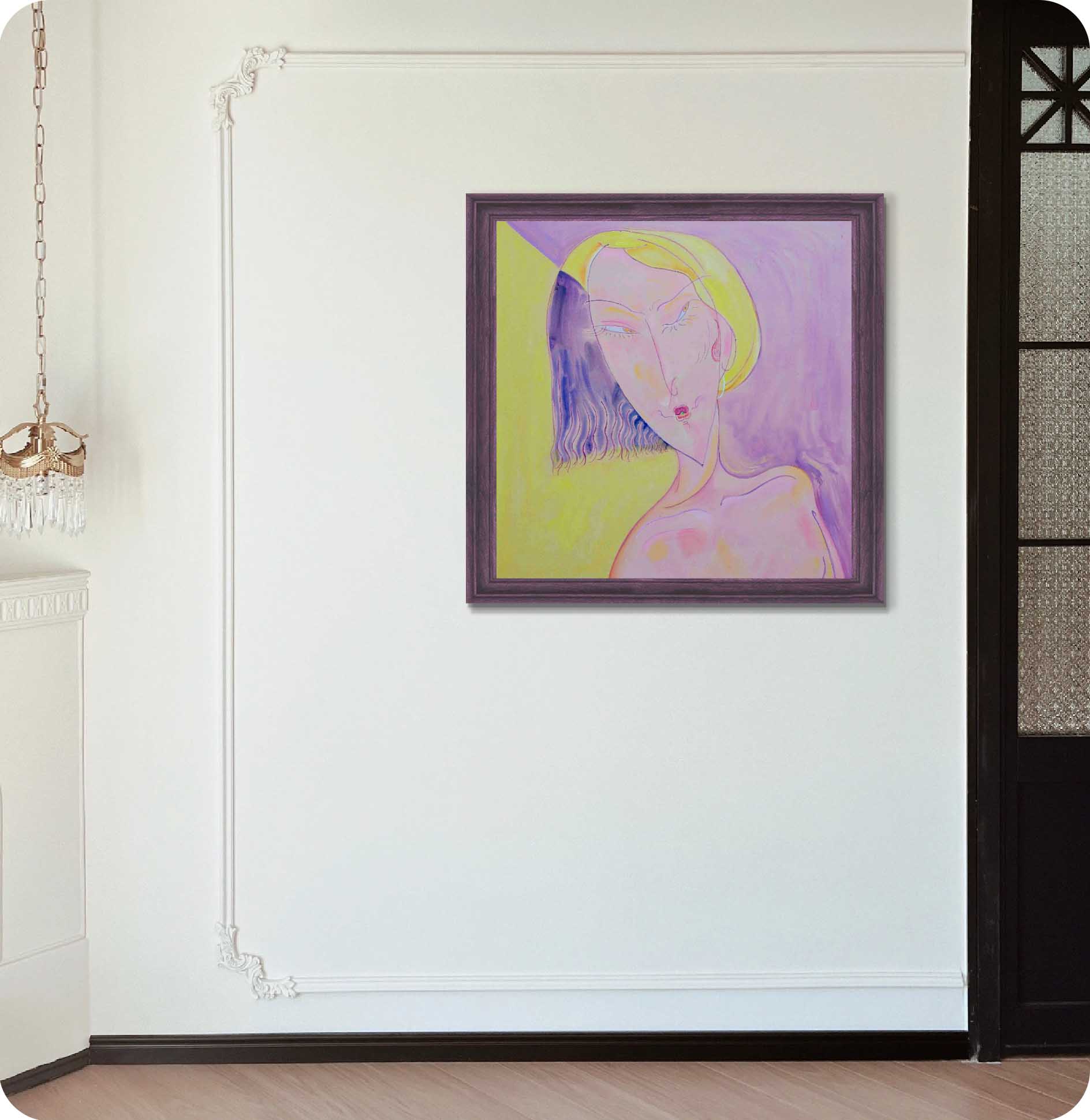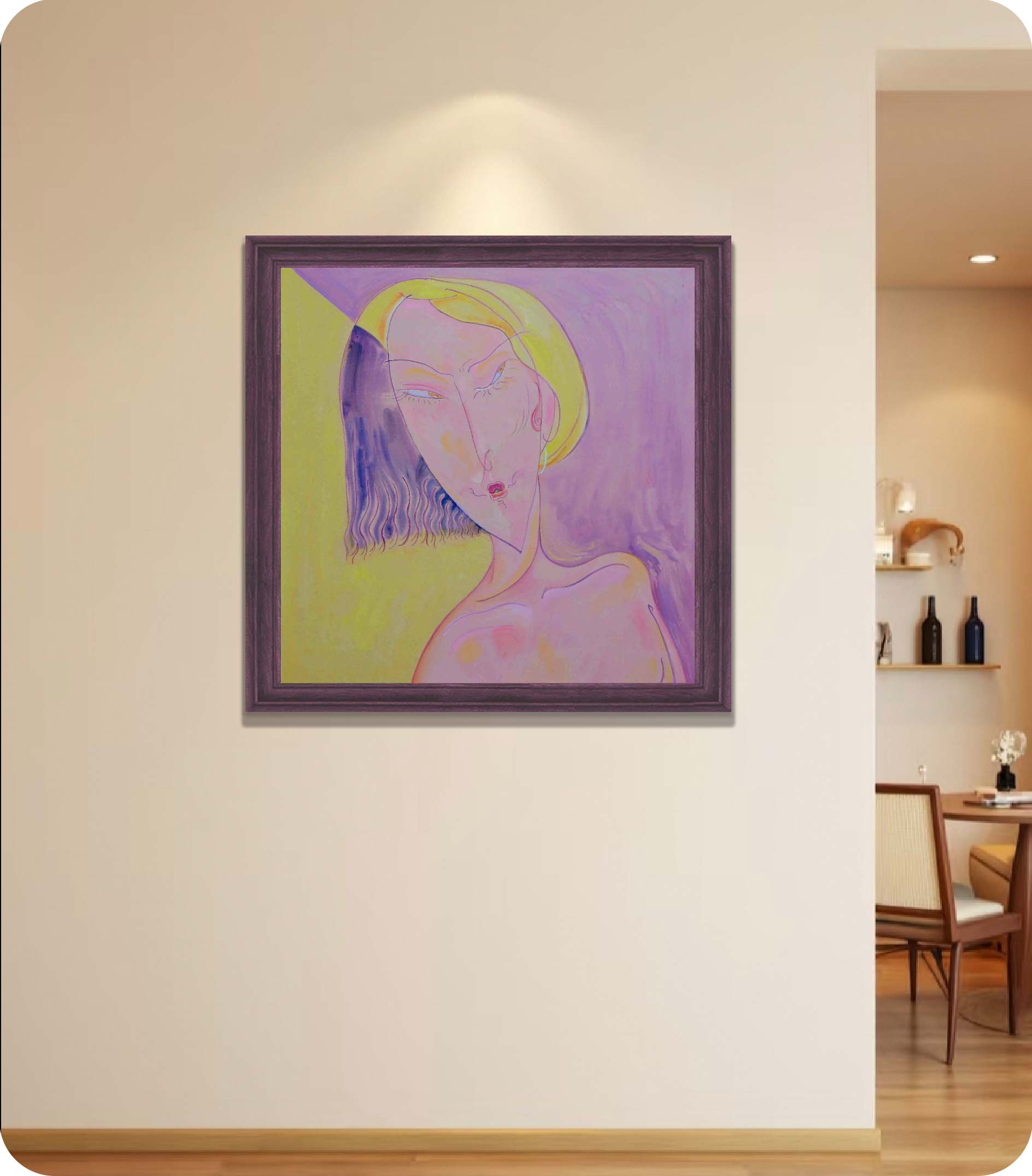The theme of this year's painting clearly states one - the makeup of desire. People's various desires are wrapped under various makeups. Desires are the intertwining of happiness and pain in life. Either straightforward or subtle, they will appear in makeup, forming a profound look of an era.
Inches: 23.6 x 23.6 in
Size without the frame: 60 x 60 cm
Country: China
Date: 2025
Materials: Acrylic painting on wood
Condition: well preserved
Creative themes and style | My works revolve around the creative concept of "The land of humanity, and the people upon it" . The people in the painting are people in nature, and the lines, shapes, and colors are close to nature. The nature in the painting is nature in the eyes of humans, existing in interaction with humans.I don’t pursue a series of works with a fixed and continuous style. I hope that the style of the pictures will synchronize with the changes in my life and always remain oscillating. The performance of the work must be in sync with the development of one's own life in order to be Sincere and powerful.Ideas are later.
An Interview with Artist Philo by Artphiloso Gallery
If you would like to collect this artwork or know more about the artist, please contact us.


Subject and Intent: The painting presents a female half-length portrait, elongated and slightly exaggerated. Its central theme lies in the juxtaposition of “inner restlessness and outward elegance.” By simplifying facial structures and using dramatic color blocks, the artist creates an impression that is both intimate and distant—much like the unsettled mood under the glaring light of summer.
Stylistic Language: The triangular elongation of the face, drawn with delicate yet assertive lines, replaces anatomical detail with minimalist contours. This approach recalls Amedeo Modigliani’s Portrait of Jeanne Hébuterne and Egon Schiele’s Woman in Red Dress, though the artist’s style here is gentler and more decorative.
Composition and Space: The square format places the figure slightly to the right, with the head tilting leftward, creating a strong diagonal tension. The painting uses a division of “light/dark” zones to convey duality: the left side in cooler, shadowy violets and blues, the right side in warm yellows and soft purples, each functioning as both background and psychological projection.
Color Strategy: Dominated by pale violets, lemon yellows, and flesh pinks, the palette relies on complementary contrasts to produce a subtle dissonance, a tension akin to summer’s unease. The yellow functions like a halo around the hair, clashing against the shadowed left side and pulling the face into the center of conflict.
Brushwork and Texture: The layers are translucent, resembling diluted acrylics or watercolor washes. Lines are fluid and lyrical, balancing color and draftsmanship—simultaneously painterly and sketch-like.
Content and Thematic Expression: Narrowed eyes, pursed lips, and contrasting hair textures form a narrative of hesitation and suppressed speech. Rather than telling a literal story, the painting conveys a psychological state—summer’s tension, both restless and repressed.
Mood and Viewer’s Relationship: The image both attracts and unsettles—the faint mocking smile and uneasy gaze compel the viewer into interaction, pulling them between beauty and discomfort.
Unconventional Details: The ear’s halo, the layered lips, and the simplified shadows of the shoulders function as symbolic cues. Minor decorative touches are magnified into emotional signals, suggesting that the figure is both portrait and icon.
Scale and Display: At 60 x 60cm, the square canvas is intimate, suited for small gallery walls or private interiors, where close viewing reveals the nuances of brushwork and layering.
Amedeo Modigliani, Portrait of Jeanne Hébuterne (1918): Comparable for its elongated face and elegant contours.
Egon Schiele, Woman in Red Dress (1910): Resonates in expressive distortion and psychological intensity.
Henri Matisse, The Green Stripe (1905): Relevant for its dramatic use of divided color fields on the face.
Alex Katz, Ada with Black Scarf (1958): Notable for its flat planes of color and modern decorative quality.
A1: The artist uses a warm-cool division to express dual psychological states—violet suggesting secrecy and shadow, yellow symbolizing performance and light. This sharp contrast magnifies the theme of duality, with the face as the focal site of tension.
A2: These stylizations trace back to Modigliani’s portrait tradition and the aesthetics of modern sketching. The artist enriches this legacy with decorative color, leaning toward contemporary lyrical abstraction.
A3: The lips serve as both visual anchor and emotional key. They symbolize a complex mix of desire, silence, and disdain, compressing the painting’s emotional message into a single gesture.
A4: Such small-scale contemporary female portraits are best suited for bedrooms, studies, or entrance halls at close viewing distance. They pair well with minimalist furnishings and soft lighting, emphasizing intimacy and artistry. They also serve as striking accents in boutique galleries or designer apartments.
A5: As an entry point into collecting small-format contemporary abstract portraiture, its value lies in the consistency of the artist’s visual language—repeated use of elongated faces, diagonal divisions, and a distinctive palette. Such features provide cohesion, recognizability, and exhibition potential, making it appealing for collectors investing in emerging contemporary artists.
A: Click here to view ARTPHILOSO's Guide for Collectors.
More paintings from this series:
A Restless Summer 1 A Restless Summer 2 A Restless Summer 4 A Restless Summer 5
A Restless Summer 6 A Restless Summer 7 A Restless Summer 8 A Restless Summer 9 A Restless Summer 10
A Restless Summer 12 A Restless Summer 13 A Restless Summer 14 A Restless Summer 15 A Restless Summer 16
